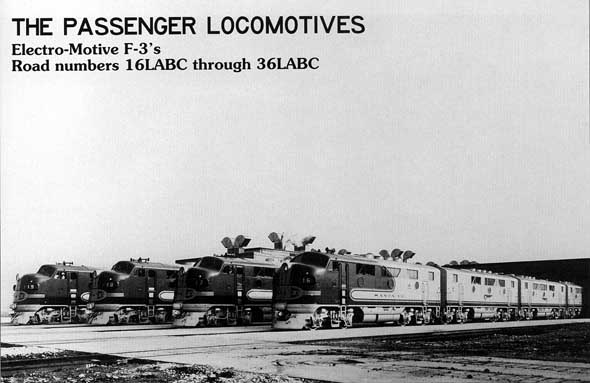 Posed for their birthday portrait at La Grange, the first four members of the 16-class of F-3's are ready to hit the Santa Fe Trail. It is November 1946 and these first units will receive many, many changes during their lives |
|
EMD's first real model change following the FT was the F3. Upgraded to a 1500 HP rating and featuring greatly improved brake, throttle, and electrical systems as well as a new carbody, the F3 set the pattern for the next decade of locomotive production. An F2 model had been produced, but it was an interim model, essentially being an F3 with an FT main generator and 1350 HP rating, intended for operation with FT's. Santa Fe had no need for F2's and did not purchase any. Santa Fe received its first F3's in November 1946 and deliveries continued into 1949 when the F3 was superseded by the F7. Santa Fe's passenger F3's comprised the 16 class (units 16LABC through 36LABC), all delivered in A-B-B-A sets, all set up for passenger service and wearing the famous red and silver paint scheme. The 16 class F3's were subject to continuous improvement, both by EMD during production and by the Santa Fe after delivery. Early units 16LABC through 21LABC featured the classic F3 appearance of raised radiator fans and slit type D/B opening in the roof, "chicken wire" screening over the upper carbody openings, and three portholes on the sides of both A and B units. They did not remain in the as-delivered configuration for long, however, as the A-units underwent a modification that eliminated the center port holes, with the entire area between the two portholes being covered with "chicken wire" screening. B-units emained mostly unchanged. EMD soon made a production change that resulted in another appearance change by the time units 22LABC through 29LABC were delivered. These units featured low profile roof fans and two portholes on the A-units with louvered filter openings between the portholes, but the "chicken wire" screening over the upper carbody openings remained. These and all subsequent passenger F's also featured stainless steel side panels in back of, and below the portholes, whereas the earlier units had painted panels. The final delivery of 16 class F3's, units 30LABC through 36LABC came from the factory with stainless steel grilles over the upper carbody openings which eliminated the unsightly "chicken wire" screening of previous production units, making them similar to the later F7 in appearance. |







